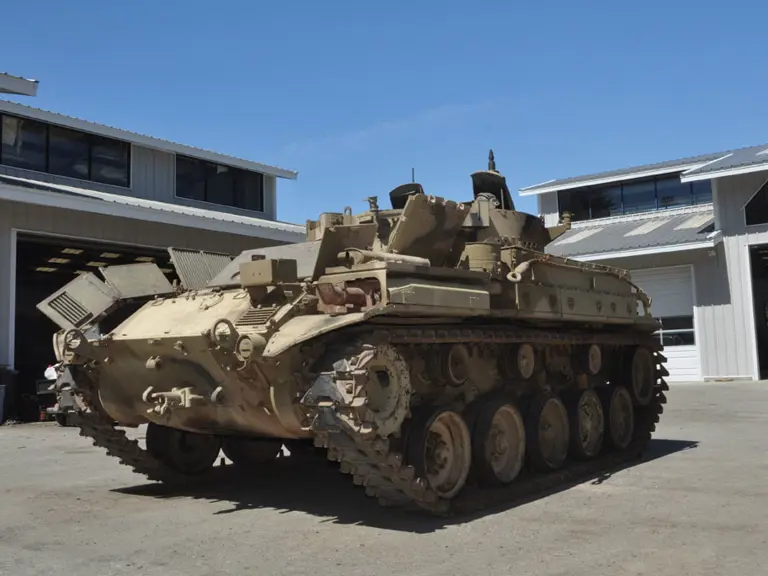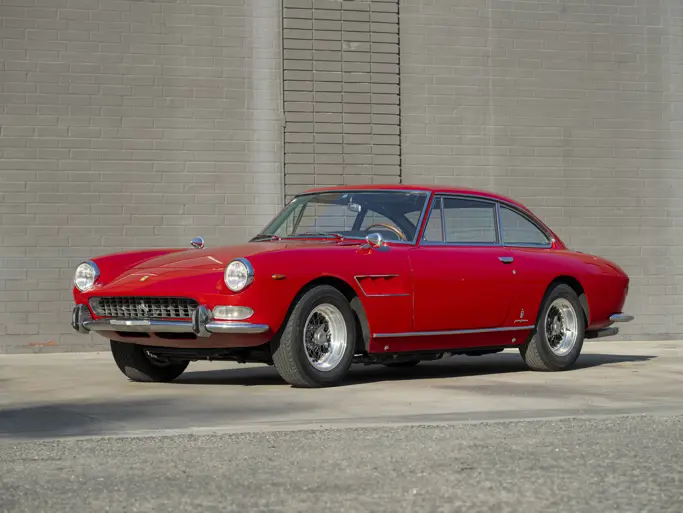 | Portola Valley, California
| Portola Valley, California
Weight: 24.9-tons (22,588-kg)
Length: 20' 2” (6.35-m)
Width: 10' 7” (3.22-m)
Height: 9' 4” (2.84-m)
Crew: 6
Armor:
Hull front: .5” (13-mm)
Turret front: .5” (13-mm)
Weapons:
Primary: 2x 40-mm Automatic Guns M2A1
Secondary: 1x .30-cal M1919A4 or 7.62-mm M60 machine gun
Ammunition:
480x 40-mm
1,750x .30-cal or 7.62-mm
Engine: Continental AOSI-895-5, 6-cylinder, 4-cycle, supercharged, fuel injection, 446-hp
Power/weight: 17.9-hp/ton
Fuel Capacity: 140-USG (530-l)
Range: 120-miles (193-km)
Speed: 45-mph (72-km/h)
The vehicle being offered, TWIN 40-mm Self-Propelled Gun M42A1 “Duster”, serial number 738, registration number 12D630, is in original and unrestored condition. It is painted in desert MERDC and retains the markings of its last unit, 3rd Battalion (Automatic Weapon), 200th Air Defense Artillery Regiment of the New Mexico Army National Guard. The interior and exterior paint both need cosmetic restoration. The wheels and tracks are in good condition. Spare track shoes are attached to the hull exterior. Two spare 40-mm gun tubes are included. A radio and various intercom boxes are mounted in the hull interior. It is unknown if they are operational.
At the beginning of the Korean War in June 1950, the U.S. Army had in service only one type of self-propelled anti-aircraft gun that used a tank chassis, the M19 40-mm gun motor carriage (GMC). The M19 GMC was based on the World War II era M24 Chaffee light tank. With the Army in the process of developing a new light tank, the T41 (soon changed to M41) during the late 1940s, it was felt prudent to develop various specialty vehicles using the new light tank chassis as well.
Development of the new self-propelled anti-aircraft vehicle, T141, was authorized in August 1951. The T141 used the chassis and rear-mounted engine compartment of the T41 light tank. A new superstructure forward of the engine compartment was added. Mounted on top of the superstructure was an open turret mounting dual 40-mm automatic cannons. The turret was a modified version of the one used on the M19 GMC. The T141 had a six-man crew consisting of a commander, driver, gunner, sight setter and two loaders.
Although development was officially authorized in August 1951, development had already been well underway as the Cadillac Motor Car Division at the Cleveland Tank Plant was able to deliver the first T141 at the end of the same month. The T141 was quickly accepted into production that same year. In April 1952, ACF Industries also began building the T141. On October 22, 1953, the T141 was officially standardized as the twin 40-mm self-propelled gun M42. Production on the M42 ended at ACF Industries in December 1953 while the Cleveland Tank Plant continued producing the M42 until June 1956. The two manufacturers built approximately 3,700.
Early on, it was shown that the Continental AOS-895-3 engine had very poor fuel economy. This was rectified in the late 1950s with the development of the Continental AOS-895-5 engine, which used fuel injection instead of a carburetor. As the new engines became available, M42 were retrofitted with them and were then redesignated M42A1. Other modifications included changing the forward hatch design and substituting pronged flash suppressor for the original cone shaped ones on the 40-mm cannon barrels.
The M42 series was issued to numerous U.S. Army air defense artillery units during the 1950s and early 1960s. In U.S. service, they never engaged aircraft in a combat situation. However, they were used in the ground support role in Vietnam providing convoy escort, perimeter and base security. Here, the high rate of fire of the twin 40-mm cannons proved very effective against North Vietnamese and Viet Cong infantry attacks. After the Vietnam War, the M42 remained in service with U.S. Army National Guard units, with the last vehicles being phased out in 1990! The M42 was exported to various U.S. allies including Jordan, Pakistan, South Vietnam, Taiwan and West Germany.
Transport Cost to Storage: $2,300





